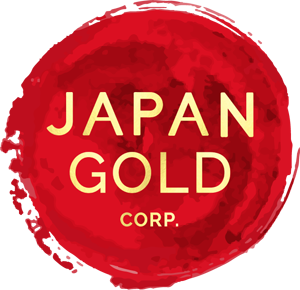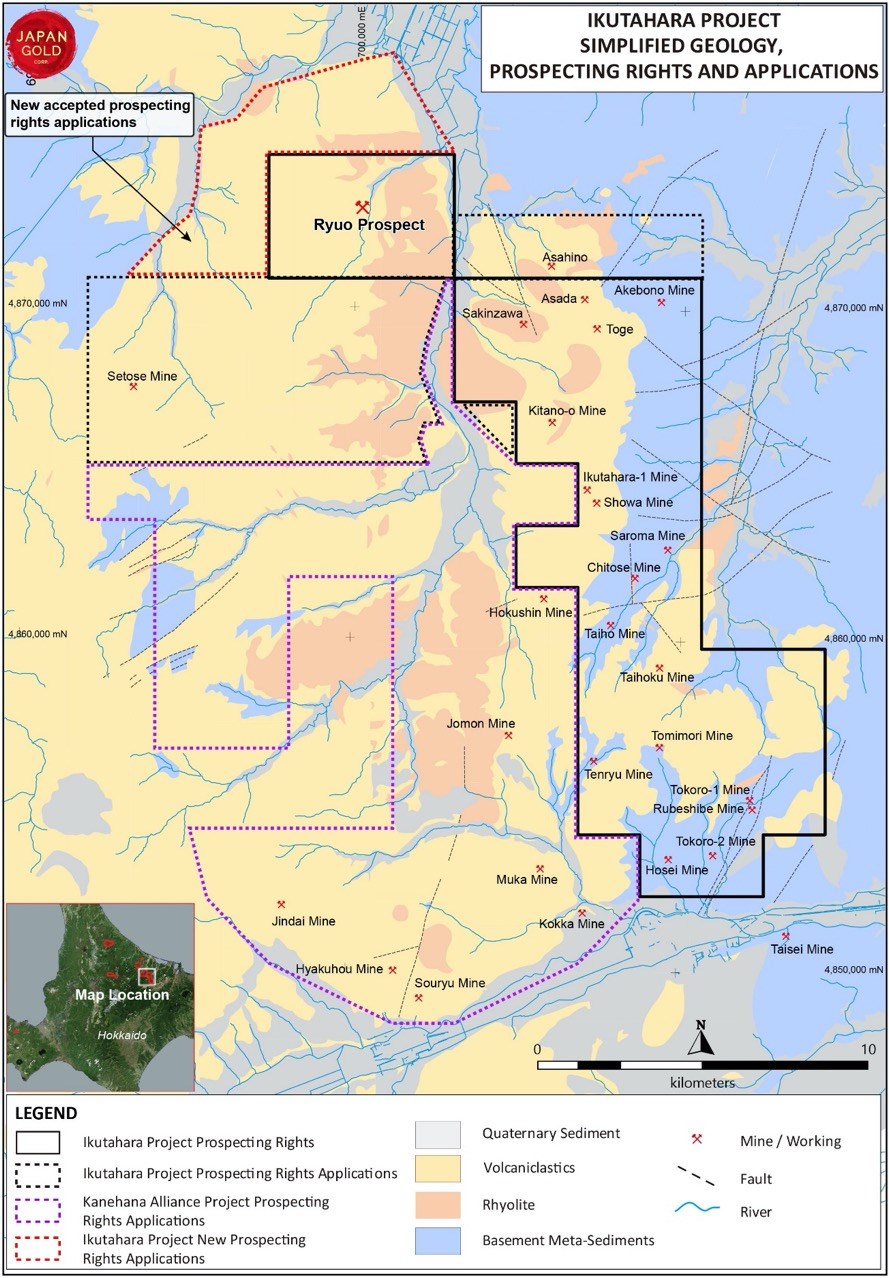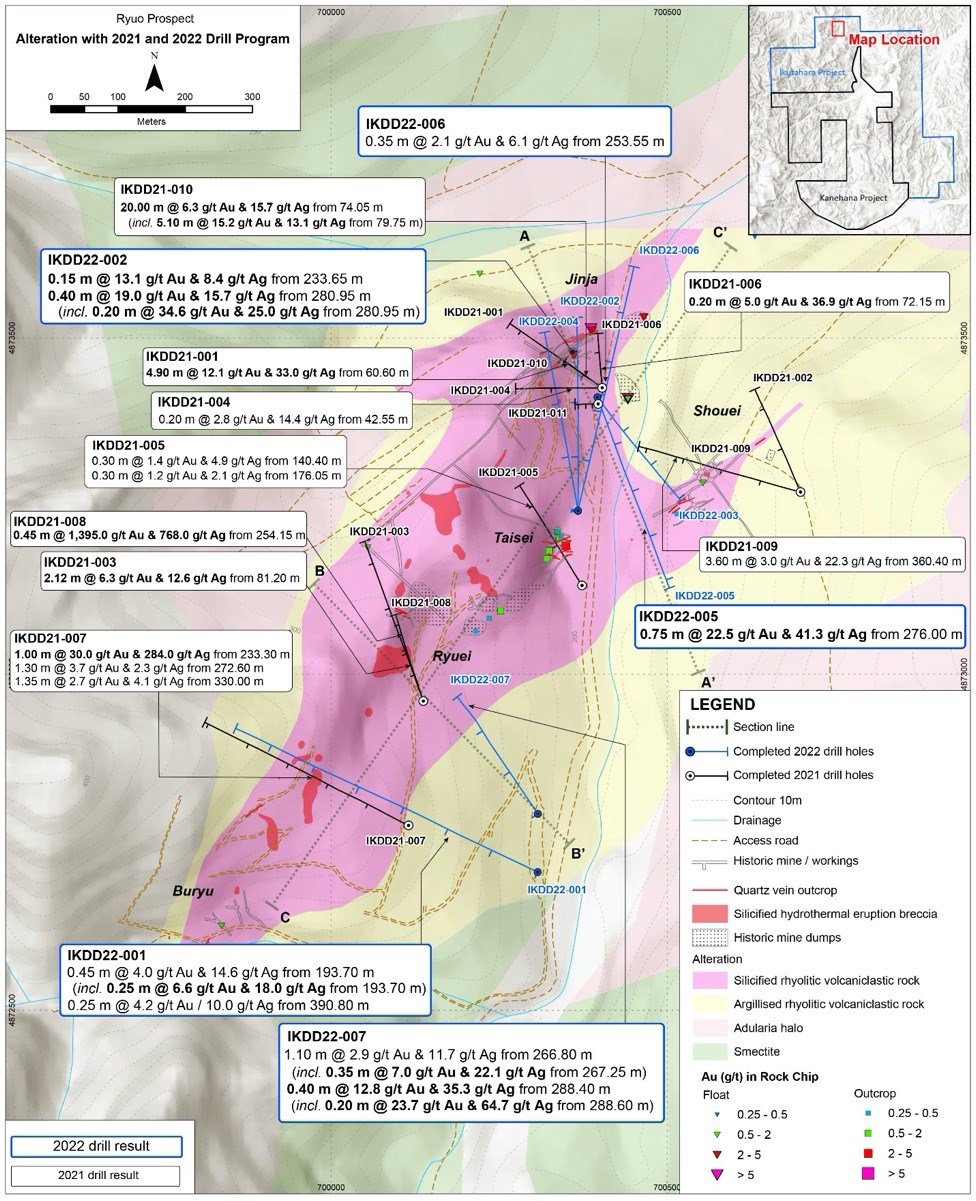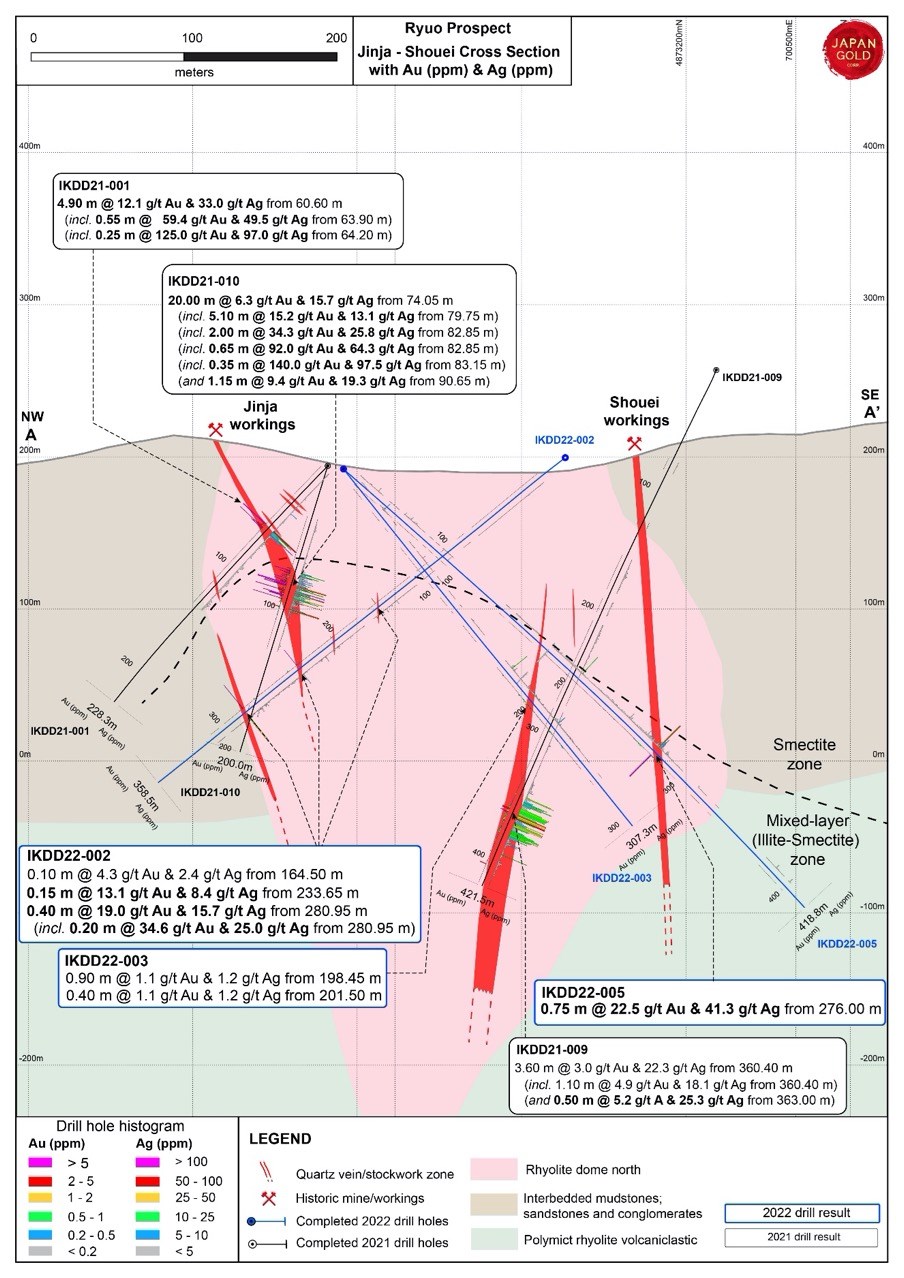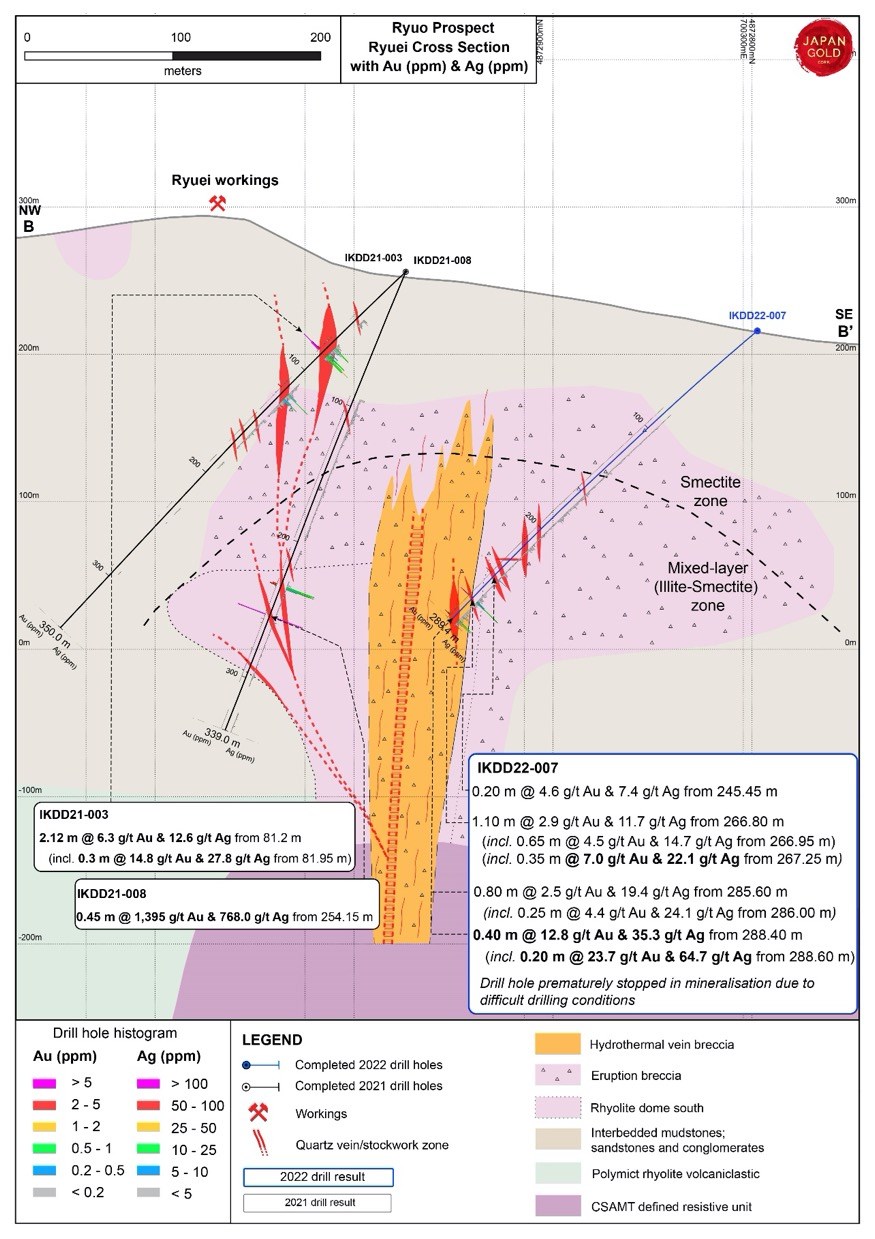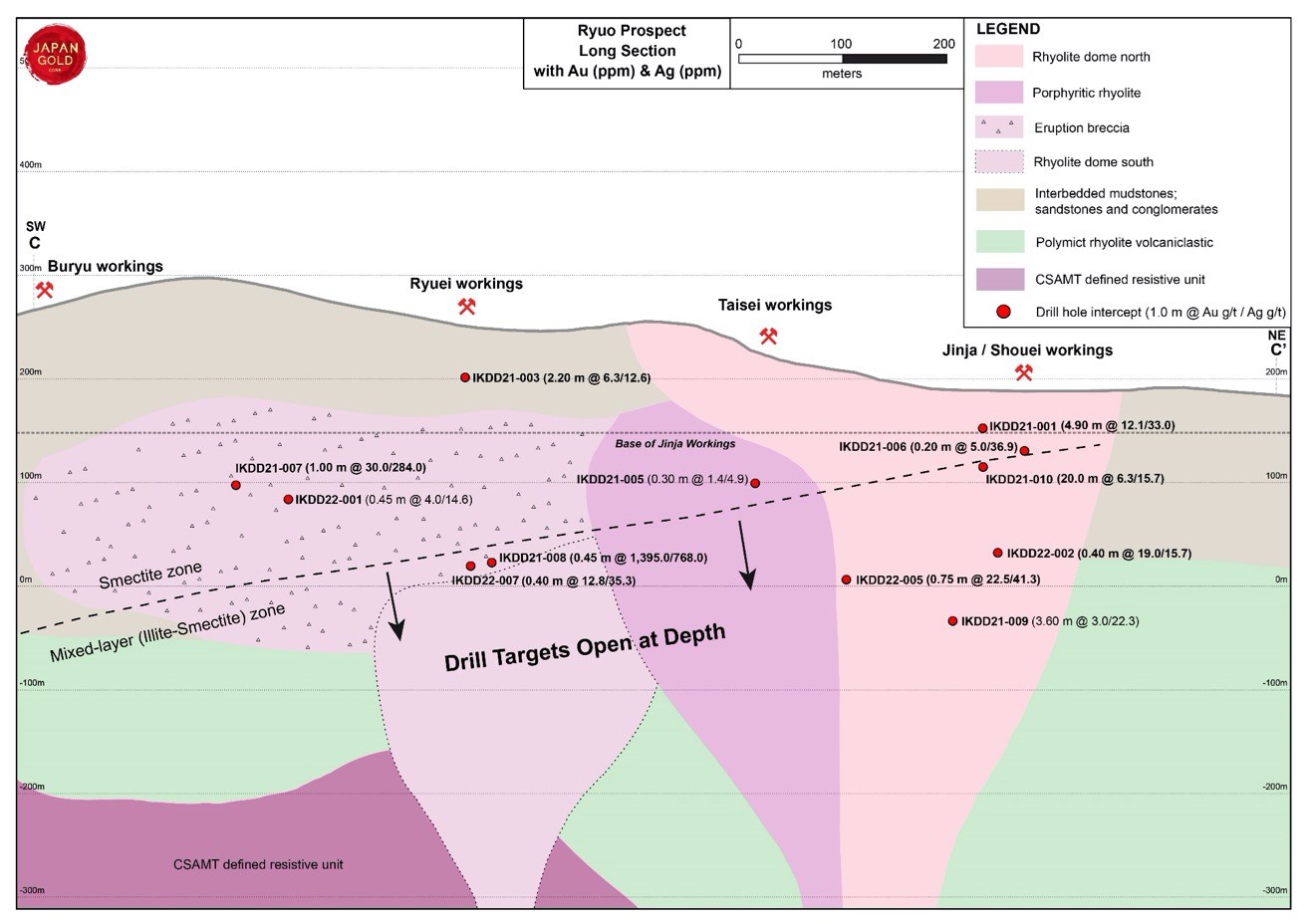Japan Gold Continues to Drill High Grade Intercepts at Ryuo and Expands the Prospect Area
Vancouver, British Columbia--(Newsfile Corp. - October 11, 2022) - Japan Gold Corp. (TSXV: JG) (OTCQB: JGLDF) ("Japan Gold" or the "Company") is pleased to announce results from seven additional drill holes at the Ryuo Prospect. Drilling has continued to encounter high-grade veins along the Ryuo alteration corridor, and interpretation of drill core has significantly advanced the understanding of controls on mineralization at the prospect. The Ryuo prospect is located within the Company's 100% owned Ikutahara Project in Hokkaido, (Figure 1).
Summary of High-Grade Intercepts, (Figures 2-5 and Table 1):
- IKDD22-005 has proven continuity of the Shouei vein 100 m to the southwest of the historical workings with the following high-grade zone from within a broader mineralized vein structure:
0.75 m @ 22.5 g/t Au & 41.3 g/t Ag from 276.0 m
- IKDD22-002: proved continuity of mineralization 50 m below the 2021 drill intercept from IKDD21-010 which intersected 20.0 m @ 6.3 g/t Au & 15.7 g/t Ag, giving the following significant interval:
0.4 m @ 19. 0 g/t Au & 15.7 Ag from 280.95 m
(Incl. 0.2 m @ 34.6 g/t Au & 25.0 g/t Ag from 280.95 m)
- IKDD22-007: targeted mineralization below IKDD21-008 which intersected the ultra-high-grade interval of 0.45 m @ 1,395 g/t Au & 768 g/t Ag. From approximately 200 m down hole IKDD22-007 encountered highly silicified and altered hydrothermally brecciated rhyolite cut by numerous banded quartz veins. The drill hole stopped in mineralization well short of its target depth under difficult drilling conditions and due to a temporary expiry of a local forestry permit, with the following significant intervals:
1.1m @ 2.9 g/t Au & 11.7 g/t Ag from 266.8 m
(incl. 0.35 m @ 7.0 g/t Au @ 22.1 g/t Ag from 267.25 m
0.4 m @ 12.8 g/t Au & 35.3 g/t Ag from 288.4 m
(incl. 0.2 m @ 23.7 g/t Au & 74.7 g/t Ag from 288.6 m)
Andrew Rowe, Vice President Exploration stated, "We are very encouraged by the recent findings at the Ryuo prospect. The combination of multiple high-grade vein structures with high-level vein textures and a well-preserved alteration system supports deeper drilling, particularly along strike to the southwest of the prospect. We look forward to completing another round of drill holes to test these concepts before the end of this year."
Summary of Findings at Ryuo and the Implications for Ongoing Exploration:
The 2022 drill program has significantly advanced the understanding of geological controls and alteration zonation with respect to high-grade mineralization at Ryuo. Importantly, high-grade gold events have been identified along the length of the prospect in multiple parallel vein zones, and alteration studies prove the system is well preserved.
IKDD22-005 has proven an extension of the Shouei vein mineralization 100 m to the southwest. Further step out drilling is required to confirm strike continuity to depth below veining intersected in the top of drill hole IKDD21-005, and towards the open high-grade mineralization intersected 400 m to the southwest in drill holes IKDD21-008 and IKDD22-007, (Figure 2 & 3).
IKDD22-007 targeting the depth extension of the ultra high-grade vein in IKDD21-008 (0.45 m @ 1,395 g/t Au & 768 g/t Ag) terminated more than 100 m before target depth under difficult drilling conditions and due to a temporary expiry of a local forestry permit. From 200 m down-hole, intensely altered and hydrothermally brecciated rhyolite was drilled to the bottom of the hole at 289.4 m. Numerous banded quartz veins cut the brecciated rhyolite carrying anomalous gold along its length, with higher grade intervals including the 40 cm vein from the bottom of the hole which gave 12.8 g/t Au & 35.5 g/t Ag with a high-grade included interval of 23.7g/t Au & 64.7 g/t Ag (Figure 4). This breccia zone was unexpected and appears to be part of a significant, partially tested mineralized structure which subsequent drilling will target as a priority.
Hydrothermal alteration of the host rocks in low-sulphidation epithermal vein systems create a distinct zonal arrangement of clay minerals. Smectite dominant assemblages form above and peripheral to quartz veining, while a mixed-layer (illite-smectite) assemblage forms in the upper parts of the gold-bearing vein zone, this progresses downward into a chlorite-illite dominant assemblage which coincides with the boiling-zone where high-grade gold deposition occurs. This association of clay zonation and gold mineralization has been well documented in literature, including at the Hishikari mine in Kyushu2.
The upper part of this zonal arrangement of clay alteration has been interpreted from spectral analysis of drill core along the length of the Ryuo prospect. A smectite dominant zone is defined above and adjacent to higher grade veins, and a mixed-layer zone is interpreted from an illite+smectite dominant assemblage, associated with most of the high-grade veining seen to date, (Figures 3 & 4). The deeper chlorite-illite assemblage has not yet been recognized at Ryuo indicating the epithermal system is preserved and that the main high-grade boiling zone lies at depth. Additionally, the smectite / mixed-layer interface at Ryuo deepens or plunges to the southwest of the prospect. Similarly, the top of the rhyolite dome complex also lies deeper in the southwest of the alteration corridor, (Figure 4). Ongoing drilling will focus on targeting the deeper portions of the Ryuo hydrothermal system for high-grade mineralization associated with in the chlorite-illite zone.
Ryuo Prospect
The Ryuo Prospect consists of five areas of workings; Jinja, Shouei, Taisei, Ryuei and Buryu that were developed along a 1.2 km long, open ended trend of alteration and mineralization prior to the government-imposed closure in 1943 (Figure 2). Historical underground sampling in the Jinja vein workings revealed high-grade gold-silver mineralization including 'level 4' of the workings, which was sampled along a 72 m strike length giving an average grade of 40.8 g/t Au and 193 g/t Ag, with an average vein width approximately 0.5 m. Figure 3 illustrates a long-section of the Jinja vein workings with the underground sampling reported by the Metal Mining Agency of Japan (MMAJ)1.
New Accepted Prospecting Rights Applications at the Ikutahara Project
Eleven new prospecting rights were lodged to cover prospective Miocene volcanics immediately to the north and west of the Ryuo prospect to ensure coverage of potential strike and parallel extension to the Ryuo mineralization. The new applications comprising a total of 2,567 hectares have now been accepted by the Ministry of Economy Trade and Industry (METI) Hokkaido, (Figure 1).
Table 1: Significant Mineralized Intercepts for IKDD22-001 to IKDD22-007
| Drill Hole Number | From (m) | To (m) | Length (m) | Au (g/t) | Ag (g/t) |
| IKDD22-001 | 161.35 | 161.50 | 0.15 | 2.6 | 22.3 |
| 193.70 | 194.15 | 0.45 | 4.0 | 14.6 | |
| incl. | 193.70 | 193.95 | 0.25 | 6.6 | 18.0 |
| 360.80 | 361.15 | 0.35 | 1.2 | 1.3 | |
| 390.00 | 390.25 | 0.25 | 4.2 | 10.0 | |
| IKDD22-002 | 164.50 | 164.60 | 0.10 | 4.3 | 2.4 |
| 233.65 | 233.80 | 0.15 | 13.1 | 8.4 | |
| 280.95 | 281.35 | 0.40 | 19.0 | 15.7 | |
| incl. | 280.95 | 281.15 | 0.20 | 34.6 | 25.0 |
| IKDD22-003 | 198.45 | 199.35 | 0.90 | 1.1 | 1.2 |
| IKDD22-004 | No Significant Intersections | ||||
| IKDD22-005 | 276.00 | 276.75 | 0.75 | 22.50 | 41.30 |
| IKDD22-006 | 253.55 | 253.90 | 0.35 | 2.10 | 6.10 |
| 309.20 | 309.40 | 0.20 | 1.50 | 1.40 | |
| IKDD22-007 | 245.45 | 245.65 | 0.20 | 4.60 | 7.40 |
| 266.80 | 267.90 | 1.10 | 2.90 | 11.70 | |
| incl. | 266.95 | 267.60 | 0.65 | 4.50 | 14.70 |
| incl. | 267.25 | 267.60 | 0.35 | 7.00 | 22.10 |
| 285.60 | 286.40 | 0.80 | 2.50 | 19.40 | |
| incl. | 286.00 | 286.25 | 0.25 | 4.40 | 24.10 |
| 288.40 | 288.80 | 0.40 | 12.80 | 35.30 | |
| incl. | 288.60 | 288.80 | 0.20 | 23.70 | 64.70 |
Table 2: Ryuo Prospect Drill Hole Data
| Drill Hole Number | Location | Easting | Northing | RL | Azimuth | Dip | Length |
| IKDD22-001 | Buryu | 700306.89 | 4872705.56 | 214.00 | 295 | -40 | 683.00 |
| IKDD22-002 | Jinja | 700367.00 | 4873243.00 | 199.00 | 0 | -35 | 358.50 |
| IKDD22-003 | Shouei | 700396.00 | 4873412.00 | 192.00 | 143 | -50 | 307.30 |
| IKDD22-004 | Jinja | 700367.00 | 4873243.00 | 199.00 | 350 | -35 | 336.00 |
| IKDD22-005 | Taisei | 700396.00 | 4873412.00 | 192.00 | 160 | -41 | 418.80 |
| IKDD22-006 | Jinja | 700367.00 | 4873243.00 | 199.00 | 13 | -40 | 495.00 |
| IKDD22-007 | Ryuei | 700307.31 | 4872792.21 | 216.00 | 325 | -40 | 289.40 |
| TOTAL | 2,888.00 | ||||||
Reference
1 Metal Mining Agency of Japan, March 1990, Geological Survey Report for Fiscal Year 1989, Northern Hokkaido Area B-Metalliferous Deposits Overview.
2 Eiji Izawa et.al. 1990. The Hishikari Gold Deposit: high-grade epithermal veins in Quaternary volcanics of southern Kyushu Japan. Journal of Geochemical Exploration, 36 (1990) pp 1-56
On behalf of the Board of Japan Gold Corp.
"John Proust"
Chairman & CEO
Qualified Person
The technical information in this news release has been reviewed and approved by Japan Gold Vice President of Exploration and Country Manager, Andrew Rowe, BAppSc, FAusIMM, FSEG, who is a Qualified Person as defined by National Instrument 43-101.
Sampling Techniques and Assaying
The drilling results discussed in this news release are from drill core samples obtained by PQ, HQ and NQ-size triple-tube diamond core drilling using a PMC700 and PMC-400 man-portable drill rigs owned and operated by the Company. The drilling program was fully supervised by Company senior geologists at the drilling site.
Drill core was collected in plastic core-trays at the drill site and transported by road in Company vehicles to its core shed storage facility in the nearby Ikutahara Village, located centrally within the project area. The drill core was carefully logged, photographed and sample intervals marked-up along predicted mineralized and selected unmineralized intervals by Japan Gold KK senior project geologists and VP Exploration.
Sample lengths varied from 0.15 to 1.0 m; depending on the positions of geological contacts and variations in vein texture and composition. The core was split by diamond rock saw supervised by project geologists. Half-core sample was collected from the entire length of each designated sample interval and placed into individual-labelled, self-sealing calico bags for secure packaging and transport to the laboratory. The half-core samples weighed between 0.25 to 5 kg depending on the sample length and core size. A Chain-of-Custody was established between the Company and receiving laboratory to ensure the integrity of the samples during transportation from site to the lab. The samples were sent in batches to ALS Laboratories in Vancouver, Canada for sample preparation and assaying.
Samples were crushed, pulverised and assayed for gold 50 g charge Fire Assay/ AAS Finish (Au-AA24; 0.005 ppm lower detection limit) and a 48 multi-element by 4-acid digest with ICP-MS determination (ME-MS61L; Ag 0.002 ppm lower detection limit). Over-limit Au and Ag samples were re-assayed by fire-assay and gravimetric finish (GRA-22, LDL of 0.5 and 5 ppm for Au and Ag respectively).
Certified Reference Materials (CRMs) were inserted by Japan Gold KK at every 20th sample to assess repeatability and assaying precision of the laboratory. In addition, the laboratory applied its own internal Quality Control procedure that includes sample duplicates, blanks & geochemical standards. They report these results with the certified Assay Report. Laboratory procedures and QAQC protocols adopted are considered appropriate. The CRMs and internal QC-QA results fall within acceptable levels of accuracy & precision and are considered to lack any bias.
Note on spectral analysis for identification of clay assemblages from drill core: ALS laboratories provides a spectral analysis of coarse sample material using TerraSpec® 4 HR and aiSIRIS™ expert spectral interpretation. Mineral assemblages are provided related to project geology. Spectral analysis used herein is interpretive for mixed layer species and used as a guide, more definitive XRD (X-Ray Diffraction) analysis are currently being undertaken to accurately identify clay species and subsequent alteration zonation for more accurate interpretations.
About Japan Gold Corp.
Japan Gold Corp. is a Canadian mineral exploration company focused solely on gold exploration across the three largest islands of Japan: Hokkaido, Honshu and Kyushu. The Company has a country-wide alliance with Barrick Gold Corporation to jointly explore, develop and mine certain gold mineral properties and mining projects. The Company holds a portfolio of 31 gold projects which cover areas with known gold occurrences, a history of mining and are prospective for high-grade epithermal gold mineralization. Japan Gold's leadership team represent decades of resource industry and business experience, and the Company has an operational team of geologists, drillers and technical advisors with experience exploring and operating in Japan. More information is available at www.japangold.com or by email at This email address is being protected from spambots. You need JavaScript enabled to view it.
For further information please contact:
John Proust
Chairman & CEO
Phone: 778-725-1491
Email: This email address is being protected from spambots. You need JavaScript enabled to view it.
Website: www.japangold.com
Cautionary Note
Neither the TSX Venture Exchange nor its Regulation Services Provider (as such term is defined in the policies of the TSX Venture Exchange) accepts responsibility for the adequacy or accuracy of this release. This news release contains forward-looking statements relating to expected or anticipated future events and anticipated results related to future partnerships and the Company's 2022 gold exploration program. These statements are forward-looking in nature and, as a result, are subject to certain risks and uncertainties that include, but are not limited to, general economic, market and business conditions; competition for qualified staff; the regulatory process and actions; technical issues; new legislation; potential delays or changes in plans; working in a new political jurisdiction; results of exploration; the timing and granting of prospecting rights; the Company's ability to execute and implement future plans, arrange or conclude a joint-venture or partnership; and the occurrence of unexpected events. Actual results achieved may differ from the information provided herein and, consequently, readers are advised not to place undue reliance on forward-looking information. The forward-looking information contained herein speaks only as of the date of this News Release. The Company disclaims any intention or obligation to update or revise forward‐looking information or to explain any material difference between such and subsequent actual events, except as required by applicable laws.
Figure 1: Ikutahara Project, new and existing prospecting rights and applications on simplified geology with historical mines and workings.
To view an enhanced version of Figure 1, please visit:
images/news_releases/2022/October/140103_57db67fc442739a5_001full.jpg
Figure 2: Ryuo prospect, alteration map with historical workings and drill holes completed to date.
To view an enhanced version of Figure 2, please visit:
images/news_releases/2022/October/140103_57db67fc442739a5_002full.jpg
Figure 3: Ryuo Prospect, Jinja & Shouei veins cross section with geology, interpreted alteration and all significant drill intersections to date.
To view an enhanced version of Figure 3, please visit:
images/news_releases/2022/October/140103_57db67fc442739a5_003full.jpg
Figure 4: Ryuo prospect, Ryuei vein cross section with geology, interpreted alteration and all significant drill intersections to date.
To view an enhanced version of Figure 4, please visit:
images/news_releases/2022/October/140103_57db67fc442739a5_004full.jpg
Figure 5: Ryuo prospect long section with geology, interpreted alteration and drill hole pierce points and significant intersections.
To view an enhanced version of Figure 5, please visit:
images/news_releases/2022/October/140103_57db67fc442739a5_005full.jpg
To view the source version of this press release, please visit https://www.newsfilecorp.com/release/140103

